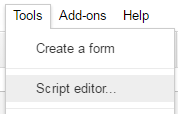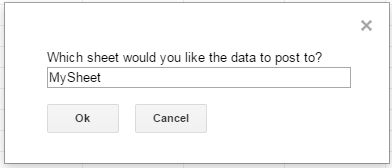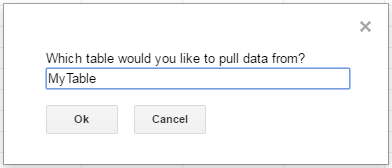Discover how a bimodal integration strategy can address the major data management challenges facing your organization today.
Get the Report →Connect to Paylocity Data in Google Apps Script
Use CData Connect Cloud to access Paylocity data in Google Apps Script.
Google Apps Script empowers users to build custom functionality within their Google documents, including Google Sheets and Google Docs. Apps Script natively supports SQL Server connectivity via JDBC, providing a powerful extensibility tool for connecting Google cloud applications to external data. Paired with the SQL connectivity offered by CData Connect Cloud, users can easily access live Paylocity data directly from within their Google documents.
This article shows how to connect to Paylocity in Connect Cloud and provides sample scripting for processing Paylocity data in a Google Spreadsheet.
Our script only reads data from a specified table, but you can easily extend the script to incorporate update functionality.
Configure Paylocity Connectivity for Google Apps Scripts
Connectivity to Paylocity from Google Apps Scripts is made possible through CData Connect Cloud. To work with Paylocity data from Google Apps Scripts, we start by creating and configuring a Paylocity connection.
CData Connect Cloud uses a straightforward, point-and-click interface to connect to data sources.
- Log into Connect Cloud, click Connections and click Add Connection
![Adding a Connection]()
- Select "Paylocity" from the Add Connection panel
![Selecting a data source]()
-
Enter the necessary authentication properties to connect to Paylocity.
Set the following to establish a connection to Paylocity:
- RSAPublicKey: Set this to the RSA Key associated with your Paylocity, if the RSA Encryption is enabled in the Paylocity account.
This property is required for executing Insert and Update statements, and it is not required if the feature is disabled.
- UseSandbox: Set to true if you are using sandbox account.
- CustomFieldsCategory: Set this to the Customfields category. This is required when IncludeCustomFields is set to true. The default value for this property is PayrollAndHR.
- Key: The AES symmetric key(base 64 encoded) encrypted with the Paylocity Public Key. It is the key used to encrypt the content.
Paylocity will decrypt the AES key using RSA decryption.
It is an optional property if the IV value not provided, The driver will generate a key internally. - IV: The AES IV (base 64 encoded) used when encrypting the content. It is an optional property if the Key value not provided, The driver will generate an IV internally.
Connect Using OAuth Authentication
You must use OAuth to authenticate with Paylocity. OAuth requires the authenticating user to interact with Paylocity using the browser. For more information, refer to the OAuth section in the Help documentation.
The Pay Entry API
The Pay Entry API is completely separate from the rest of the Paylocity API. It uses a separate Client ID and Secret, and must be explicitly requested from Paylocity for access to be granted for an account. The Pay Entry API allows you to automatically submit payroll information for individual employees, and little else. Due to the extremely limited nature of what is offered by the Pay Entry API, we have elected not to give it a separate schema, but it may be enabled via the UsePayEntryAPI connection property.
Please be aware that when setting UsePayEntryAPI to true, you may only use the CreatePayEntryImportBatch & MergePayEntryImportBatchgtable stored procedures, the InputTimeEntry table, and the OAuth stored procedures. Attempts to use other features of the product will result in an error. You must also store your OAuthAccessToken separately, which often means setting a different OAuthSettingsLocation when using this connection property.
![Configuring a connection (Salesforce is shown)]()
- RSAPublicKey: Set this to the RSA Key associated with your Paylocity, if the RSA Encryption is enabled in the Paylocity account.
- Click Create & Test
- Navigate to the Permissions tab in the Add Paylocity Connection page and update the User-based permissions.
![Updating permissions]()
Add a Personal Access Token
If you are connecting from a service, application, platform, or framework that does not support OAuth authentication, you can create a Personal Access Token (PAT) to use for authentication. Best practices would dictate that you create a separate PAT for each service, to maintain granularity of access.
- Click on your username at the top right of the Connect Cloud app and click User Profile.
- On the User Profile page, scroll down to the Personal Access Tokens section and click Create PAT.
- Give your PAT a name and click Create.
![Creating a new PAT]()
- The personal access token is only visible at creation, so be sure to copy it and store it securely for future use.
With the connection configured, you are ready to connect to Paylocity data from Google Apps Script.
Connect to Paylocity Data from Apps Script
At this point, you should have configured a connection Paylocity in Connect Cloud. All that is left new is to use Google Apps Script to access Connect Cloud and work with your Paylocity data in Google Sheets.
In this section, you will create a script (with a menu option to call the script) to populate a spreadsheet with Paylocity data. We have created a sample script and explained the different parts. You can view the raw script at the and of the article.
1. Create an Empty Script
To create a script for your Google Sheet, click Tools Script editor from the Google Sheets menu:

2. Declare Class Variables
Create a handful of class variables to be available for any functions created in the script.
//replace the variables in this block with real values as needed var address = 'tds.cdata.com:14333'; var user = 'CONNECT_USER'; // [email protected] var userPwd = 'CONNECT_USER_PAT'; var db = 'Paylocity1'; var dbUrl = 'jdbc:sqlserver://' + address + ';databaseName=' + db;
3. Add a Menu Option
This function adds a menu option to your Google Sheet, allowing you to use the UI to call your function.
function onOpen() {
var spreadsheet = SpreadsheetApp.getActive();
var menuItems = [
{name: 'Write data to a sheet', functionName: 'connectToPaylocityData'}
];
spreadsheet.addMenu('Paylocity Data', menuItems);
}

4. Write a Helper Function
This function is used to find the first empty row in a spreadsheet.
/*
* Finds the first empty row in a spreadsheet by scanning an array of columns
* @return The row number of the first empty row.
*/
function getFirstEmptyRowByColumnArray(spreadSheet, column) {
var column = spreadSheet.getRange(column + ":" + column);
var values = column.getValues(); // get all data in one call
var ct = 0;
while ( values[ct] && values[ct][0] != "" ) {
ct++;
}
return (ct+1);
}
5. Write a Function to Write Paylocity Data to a Spreadsheet
The function below writes the Paylocity data, using the Google Apps Script JDBC functionality to connect to Connect Cloud, SELECT data, and populate a spreadsheet. When the script is run, two input boxes will appear:
The first one asks the user to input the name of a sheet to hold the data (if the spreadsheet does not exist, the function creates it).

The second asks the user to input the name of a Paylocity table to read. If an invalid table is chosen, an error message appears and the function is exited.

Note, while the function is designed for use as a menu option, you can extend it for use as a spreadsheet formula.
/*
* Reads data from a specified Paylocity 'table' and writes it to the specified sheet.
* (If the specified sheet does not exist, it is created.)
*/
function connectToPaylocityData() {
var thisWorkbook = SpreadsheetApp.getActive();
//select a sheet and create it if it does not exist
var selectedSheet = Browser.inputBox('Which sheet would you like the data to post to?',Browser.Buttons.OK_CANCEL);
if (selectedSheet == 'cancel')
return;
if (thisWorkbook.getSheetByName(selectedSheet) == null)
thisWorkbook.insertSheet(selectedSheet);
var resultSheet = thisWorkbook.getSheetByName(selectedSheet);
var rowNum = 2;
//select a Paylocity 'table'
var table = Browser.inputBox('Which table would you like to pull data from?',Browser.Buttons.OK_CANCEL);
if (table == 'cancel')
return;
var name = Jdbc.getConnection(dbUrl, {
user: user,
password: userPwd
}
);
//confirm that var table is a valid table/view
var dbMetaData = name.getMetaData();
var tableSet = dbMetaData.getTables(null, null, table, null);
var validTable = false;
while (tableSet.next()) {
var tempTable = tableSet.getString(3);
if (table.toUpperCase() == tempTable.toUpperCase()){
table = tempTable;
validTable = true;
break;
}
}
tableSet.close();
if (!validTable) {
Browser.msgBox("Invalid table name: " + table, Browser.Buttons.OK);
return;
}
var stmt = name.createStatement();
var results = stmt.executeQuery('SELECT * FROM ' + table);
var rsmd = results.getMetaData();
var numCols = rsmd.getColumnCount();
//if the sheet is empty, populate the first row with the headers
var firstEmptyRow = getFirstEmptyRowByColumnArray(resultSheet, "A");
if (firstEmptyRow == 1) {
//collect column names
var headers = new Array(new Array(numCols));
for (var col = 0; col < numCols; col++){
headers[0][col] = rsmd.getColumnName(col+1);
}
resultSheet.getRange(1, 1, headers.length, headers[0].length).setValues(headers);
} else {
rowNum = firstEmptyRow;
}
//write rows of Paylocity data to the sheet
var values = new Array(new Array(numCols));
while (results.next()) {
for (var col = 0; col < numCols; col++) {
values[0][col] = results.getString(col + 1);
}
resultSheet.getRange(rowNum, 1, 1, numCols).setValues(values);
rowNum++;
}
results.close();
stmt.close();
}
When the function is completed, you have a spreadsheet populated with your Paylocity data, and you can now leverage all of the calculating, graphing, and charting functionality of Google Sheets anywhere you have access to the Internet.
Complete Google Apps Script
//replace the variables in this block with real values as needed var address = 'tds.cdata.com:14333'; var user = 'CONNECT_USER'; // [email protected] var userPwd = 'CONNECT_USER_PAT'; var db = 'Paylocity1'; var dbUrl = 'jdbc:sqlserver://' + address + ';databaseName=' + db; function onOpen() { var spreadsheet = SpreadsheetApp.getActive(); var menuItems = [ {name: 'Write table data to a sheet', functionName: 'connectToPaylocityData'} ]; spreadsheet.addMenu('Paylocity Data', menuItems); } /* * Finds the first empty row in a spreadsheet by scanning an array of columns * @return The row number of the first empty row. */ function getFirstEmptyRowByColumnArray(spreadSheet, column) { var column = spreadSheet.getRange(column + ":" + column); var values = column.getValues(); // get all data in one call var ct = 0; while ( values[ct] && values[ct][0] != "" ) { ct++; } return (ct+1); } /* * Reads data from a specified 'table' and writes it to the specified sheet. * (If the specified sheet does not exist, it is created.) */ function connectToPaylocityData() { var thisWorkbook = SpreadsheetApp.getActive(); //select a sheet and create it if it does not exist var selectedSheet = Browser.inputBox('Which sheet would you like the data to post to?',Browser.Buttons.OK_CANCEL); if (selectedSheet == 'cancel') return; if (thisWorkbook.getSheetByName(selectedSheet) == null) thisWorkbook.insertSheet(selectedSheet); var resultSheet = thisWorkbook.getSheetByName(selectedSheet); var rowNum = 2; //select a Paylocity 'table' var table = Browser.inputBox('Which table would you like to pull data from?',Browser.Buttons.OK_CANCEL); if (table == 'cancel') return; var name = Jdbc.getConnection(dbUrl, { user: user, password: userPwd } ); //confirm that var table is a valid table/view var dbMetaData = name.getMetaData(); var tableSet = dbMetaData.getTables(null, null, table, null); var validTable = false; while (tableSet.next()) { var tempTable = tableSet.getString(3); if (table.toUpperCase() == tempTable.toUpperCase()){ table = tempTable; validTable = true; break; } } tableSet.close(); if (!validTable) { Browser.msgBox("Invalid table name: " + table, Browser.Buttons.OK); return; } var stmt = name.createStatement(); var results = stmt.executeQuery('SELECT * FROM ' + table); var rsmd = results.getMetaData(); var numCols = rsmd.getColumnCount(); //if the sheet is empty, populate the first row with the headers var firstEmptyRow = getFirstEmptyRowByColumnArray(resultSheet, "A"); if (firstEmptyRow == 1) { //collect column names var headers = new Array(new Array(numCols)); for (var col = 0; col < numCols; col++){ headers[0][col] = rsmd.getColumnName(col+1); } resultSheet.getRange(1, 1, headers.length, headers[0].length).setValues(headers); } else { rowNum = firstEmptyRow; } //write rows of Paylocity data to the sheet var values = new Array(new Array(numCols)); while (results.next()) { for (var col = 0; col < numCols; col++) { values[0][col] = results.getString(col + 1); } resultSheet.getRange(rowNum, 1, 1, numCols).setValues(values); rowNum++; } results.close(); stmt.close(); }










